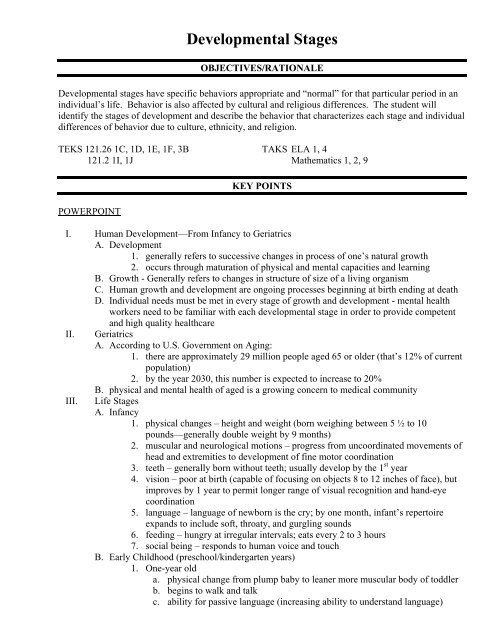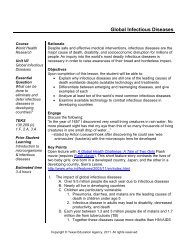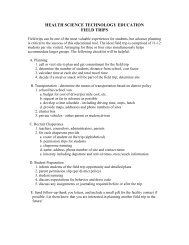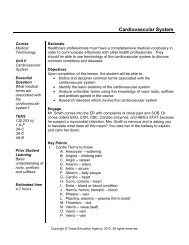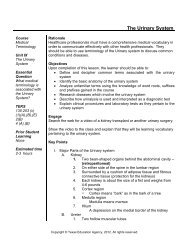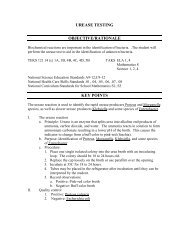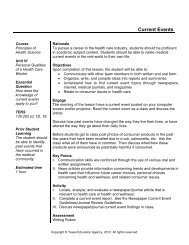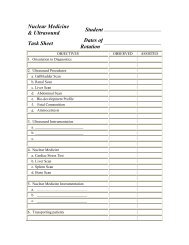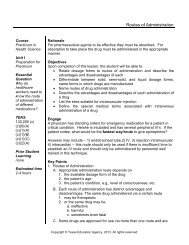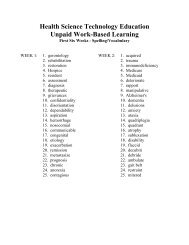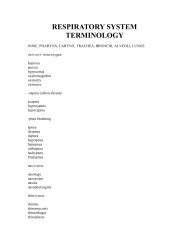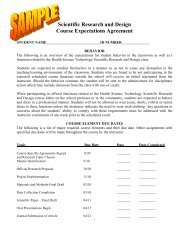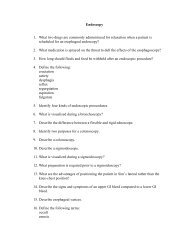Developmental Stages
Developmental Stages
Developmental Stages
Create successful ePaper yourself
Turn your PDF publications into a flip-book with our unique Google optimized e-Paper software.
<strong>Developmental</strong> <strong>Stages</strong>OBJECTIVES/RATIONALE<strong>Developmental</strong> stages have specific behaviors appropriate and “normal” for that particular period in anindividual’s life. Behavior is also affected by cultural and religious differences. The student willidentify the stages of development and describe the behavior that characterizes each stage and individualdifferences of behavior due to culture, ethnicity, and religion.TEKS 121.26 1C, 1D, 1E, 1F, 3B TAKS ELA 1, 4121.2 1I, 1J Mathematics 1, 2, 9POWERPOINTKEY POINTSI. Human Development—From Infancy to GeriatricsA. Development1. generally refers to successive changes in process of one’s natural growth2. occurs through maturation of physical and mental capacities and learningB. Growth - Generally refers to changes in structure of size of a living organismC. Human growth and development are ongoing processes beginning at birth ending at deathD. Individual needs must be met in every stage of growth and development - mental healthworkers need to be familiar with each developmental stage in order to provide competentand high quality healthcareII. GeriatricsA. According to U.S. Government on Aging:1. there are approximately 29 million people aged 65 or older (that’s 12% of currentpopulation)2. by the year 2030, this number is expected to increase to 20%B. physical and mental health of aged is a growing concern to medical communityIII. Life <strong>Stages</strong>A. Infancy1. physical changes – height and weight (born weighing between 5 ½ to 10pounds—generally double weight by 9 months)2. muscular and neurological motions – progress from uncoordinated movements ofhead and extremities to development of fine motor coordination3. teeth – generally born without teeth; usually develop by the 1 st year4. vision – poor at birth (capable of focusing on objects 8 to 12 inches of face), butimproves by 1 year to permit longer range of visual recognition and hand-eyecoordination5. language – language of newborn is the cry; by one month, infant’s repertoireexpands to include soft, throaty, and gurgling sounds6. feeding – hungry at irregular intervals; eats every 2 to 3 hours7. social being – responds to human voice and touchB. Early Childhood (preschool/kindergarten years)1. One-year olda. physical change from plump baby to leaner more muscular body of toddlerb. begins to walk and talkc. ability for passive language (increasing ability to understand language)
d. tentative sense of independencee. determined explorer; constantly exploring by touching, holding climbing,and mouthing2. Two-year olda. begins to communicate verbally; most can tell their own name and names ofcommon objectsb. can usually speak in 3 to 4 word sentences and carry on brief conversationsc. famous for negative behavior1) temper tantrums (most often out of frustration)2) say “NO” to everythingd. do not actively play with other children, rather enjoy playing side by sidechildren their agee. great imitators3. Three-year olda. more coordinated than the two-year old; climbs stairs with alternating feetand can stand briefly on one footb. vocabulary and pronunciation continue to expandc. emotionally, three-year old loves parents and wants to be just like them4. Four-year olda. sentences more complex; speaks well enough for strangers to understandb. imagination is vivid; line between what is real and imaginary often indistinctc. develops fears (common fears include: fear of dark, fear of animals, andfear of death)5. Five-year olda. can hop on one foot and skipb. can accurately copy figures such as trianglec. continues to develop language skillsd. many begin to reade. social with other children their ageC. Late Childhood (preadolescence 6-12 years)1. physical development at a slow, but steady rate2. both large and small muscles are well-developed3. able to participate in physical activities that require complex motor skills andcoordination4. visual acuity has matured to its best5. stage to learn morals and values6. progress from independent activities to group activities with members of same sex7. acceptance by peers is very important8. parental approval and reassurance are still basic needsD. Adolescence (begins around 12 or 13 and goes to 19 or 20 years)1. traumatic life stage for both child and any authoritative figure2. puberty occurs; physical changes occur rapidly during early years of this stage3. muscle coordination does not occur as quickly as physical changes; can makechild clumsy and awkward4. stage where individuals learn to be accountable and accept responsibility foractions5. extremely concerned with appearance (their appearance and others)6. trying to establish self-identity7. feelings of uncertainty, inadequacy, and insecurity may surface8. confrontations with authorityE. Young Adult (20-45 years)1. physical development complete and motor coordination is at its peak
IV.2. emotional maturation continues to develop3. usually learned to accept responsibility for actions and to accept criticism4. usually knows how to profit from errors5. socially progressed from peer groups to associates with similar ambitions anddesires (regardless of age)F. Middle Adulthood (40-45 to 55 years)1. physical changes begin to occur (hair begins to thin and gray; wrinkles appear,muscles may lose tone and strength, hearing and vision may decrease)2. main concerns: children, health, job security, aging parents, and fear of aging3. love and acceptance still major role in lives of these individualsG. Late Adulthood – fastest growing age bracket of society (55-60 and up)1. physical deterioration (brittle bones, skin dry and wrinkled, poor coordination)2. some memory problems3. coping with retirement and forms of entertainment4. chronically concerned with health5. concerned with finances6. significant number of elderly become depressed; suicide rate is high7. needs of elderly same as other life stages—feeling of acceptance, love, selfesteem,and financial securityIndividual DifferencesA. Cultural/Subcultural differences – value systems, body language, proximecsB. Ethnic differences – skin tones, facial features, languageC. Religious differences – Protestant, Catholic, Jewish, Buddhists, Agnostic, Muslim, etc.D. Physical differences – large/small, thin/fat, anomalies, disabilitiesE. Personalities – inherent predisposition to be outgoing, shy, sensitive, creative, etc.ACTIVITIESI. Complete the personality profile and discuss characteristics of the different personality types.Calculate percentage of different personalities types in the class.II. Participate in a group discussion: Why is it important as a mental health professional torecognize chronic lack of age-appropriate behavior in individuals? (See Activity Guidelines)III. Invite a small panel of senior citizens to speak about growing up during the 20 th -century.Teacher Note This activity was utilized with a general psych class—it was great! Our seniorfriends love to talk and they gave the students insight as to what is considered “normal”according to social beliefs and world events –Great Depression, WWII, Social revolution of the‘60s, etc.) Ask senior friends if they would bring pictures from their youth. Students shouldprepare discussion questions ahead of time.MATERIALS NEEDEDUnderstanding Yourself and Others Personality ProfileActivity Guideline: Age-Appropriate BehaviorMental Health and Mental Illness, Sixth Edition, Patricia D. Barry, ISBN 0-397-55473-7, (Chapter 9)Study Guide for Human Development/Understanding the Patient
Key for worksheetVideo: Gross Anatomy (for enrichment activity)Member of a Team RubricCompletion of Personality ProfileASSESSMENTACCOMMODATIONSFor reinforcement, the student will complete the Study Guide for Human Development/ Understandingthe Patient.For enrichment, the students will evaluate the video Gross Anatomy and describe the “color” personalityof each person that made up the gross anatomy dissection group. Based on this video, the students willpredict contributions that different personalities can bring to groups.REFLECTIONS
Understanding Yourself and Others Personality ProfileThere are no “right” or “wrong” answers. This questionnaire will help you to determine your preferred socialstyle. The results will provide an insight into:• new awareness about yourself & others• solving conflicts with others• leadership, teamwork, & relationship insightCIRCLE ONE WORD OR PHRASE PER LINE THAT BEST DESCRIBES YOUR BEHAVIOR STYLE:1. assertive conforming sensitive trusting2. spontaneous checks with others mentally visualize analyze/investigate3. involved orderly straight forward like to explore4. stubborn dictatorial rebellious easily discouraged5. demanding manipulative uncooperative silent/quiet6. connects/joins idea person resists change in charge7. cautious kindhearted harmony active8. caring outspoken consistent behavior mild9. convincing aggressive disciplined possessive10. daring dreamer obedient participating11. logical satisfied friendly bold12. “eager beaver” imaginative accurate/precise popular13. reserved innovative/new ideas forceful optimistic14. power teamwork individual conservative15. talkative restless attentive modest16. leader counselor designer controller17. methodical workaholic helpful self-directed18. industrious detailed mentally active hopeful19. task-oriented people-oriented idea-oriented result-oriented20. emotional flexible likes recognition precise21. irritable rigid resentful easily threatened22. indirect frank careful exact23. goal oriented volunteers for jobscompetent & steadyschedule oriented24. excels in emergencies thrives on complimentsdry sense of humoravoids causing attention25. enjoys watching people strong-willed, decisiveenergy & enthusiasmperfectionist, high standards26. makes friends cautiously behaves or dresses in flashy wayvery self-confidentpersistent & thorough27. neat & tidy looks good on surfaceavoids conflictsis usually right
Understanding Yourself and Others Personality ProfileScore Sheet1. red green blue yellow2. red yellow blue green3. yellow green red red4. green red yellow blue5. red yellow green blue6. yellow blue green red7. green blue yellow red8. yellow red green blue9. yellow red green blue10. red blue green yellow11. green blue yellow red12. red blue green yellow13. green blue red yellow14. red yellow blue green15. yellow red green blue16. red yellow blue green17. green red yellow blue18. red green blue yellow19. green yellow blue red20. blue yellow red green21. red green blue yellow22. yellow red blue green23. red yellowbluegreen24. red yellowbluegreen25. blue redyellowgreen26. blue yellowredgreen27. green yellowblueredProfile Totals:RED ____________ YELLOW _____________ BLUE _____________ GREEN ____________
Description of four basic personality types:Red -Yellow -Green -Blue -task and result orientedhonestlikes recognitioncan’t sit stilldoesn’t like to be lateenjoys individual sports (gold, fishing, tennis, etc.)car: expensive or showy (often sports car)swing set: pays to have someone put it togetherpeople orientedexpressivefriendlyloves to talkextravagantoptimistenjoys team sports (football, basketball, etc.)car: large enough to carry friends around in (CRV, van)swing set: come to my house for a partydetail orientedPrecisecontrolledthriftydoes thing right the first timecompletes the jobcar: practical (small recreation vehicle, economy)swing set: remove from carton carefully in case it must be returned,count pieces, reads instructionscreatively orientedsincereloyalcaringsensitiveunderstandingopen-mindedenjoys naturecar: jeepswing set: design it and build it from scratch
Name ______________________________Date __________________________Study Guide for: Human Needs/Understanding the Patient1. Reference to changes in structure or size of a living organism (i.e. human) is called:________________________________2. According to studies done by our government, _____________ percent of the population are aged 65years or older.3. The life stage where puberty occurs is _______________________________.4. In this age group (age group), a significant number of people become depressed and there is a highsuicide rate. _____________________________________5. Changes that occur over time in the process of one’s natural growth is referred to as____________________________________.6. Infants usually double their weight by what age? ___________________________________7. The life stage whereby visual acuity is at its best is during: ________________________________.8. At what age should one expect children to have trouble distinguishing between what is imaginaryand what is real? ____________________________9. Physical development is complete by what life stage? ____________________________________10. At which life stage are people most concerned with their health?_________________________________11. List four individual differences that health care professionals should be aware of when taking care ofpatients:1) 3)2) 4)12. The age range for late childhood is from ____________ years of age to ____________ years old.13. Newborn infants are able to see almost immediately after birth, but can only focus on objects withina range of: _________________________________.13. The “determined explorer” describes a child who is how old? ___________________________14. At this age, a child loves his/her parents and wants to be just like them. ____________________15. Motor coordination is at its peak during the ____________________________________ life stage.16. Middle adulthood begins at what age? ________________________________17. How frequently should one expect newborns to be hungry? ________________________________
18. Children are famous for temper tantrums at this age: ________________________________19. Children learn their morals and values by this life stage: ________________________________20. The age at which children commonly develop fears is : ____________________________21. “Identity crisis” might be used to describe this stage: ______________________________22. By the time a child is five, he or she should be capable of what kind of physical activity?__________________________________23. Children are often clumsy at this age due to muscle coordination not occurring as quickly as theirbody growth: __________________________________24. At what life stage will people associate with other individuals with life interests rather than peersjust within their age bracket? _______________________________25. The main concerns of middle adulthood are: ______________________________________________________________________________________________________________________________.26. Brittle bones and poor coordination describe this life stage: _______________________________MATCHING:A. infancy D. adolescenceB. early childhood/presch. kindergarten E. young adulthoodC. late childhood (preadolescence) F. middle adulthoodG. late adulthood________1. acceptance by peers is very important________2. confrontations with authority________ 3. age 65 & older________ 4. great imitator________ 5. accurately copies abstract signs & drawings_______ 6 usually knows how to profit from errors________7. from 12 to 20 years old________8. begins to walk and talk________9. climbs stairs with alternating feet_______16. ability to understand language (passive language)_______17. “NO” to everything!_______18. goes from plump baby to leaner toddler_______19. uncoordinated movements to fine motorcoordination_______20. often feels insecure and inadequate_______21. very concerned with finances_______22. speaks in 3 & 4 word sentences_______23. enjoys being with other children, but does notactively play with them________10. generally begins to read________11. speaks well enough for strangers to understand________12. problem life stage for both parent & child________13. hair begins to thin & gray________14. learns to accept responsibility for actions________15. fastest growing age bracket
Key: WorksheetHuman Needs/Understanding the Patient1. growth2. 12%3. adolescence4. late adulthood5. development6. 9 months7. late childhood8. 4-year-old9. young adulthood10. late adulthood11. (any four of the followning) cultural or subcultural differences, ethic differences, religiousdifferences, physical differences, personalities12. 6-12 years13. 8 to 12 inches of face14. 3-year-old15. young adulthood16. 40 years17. every 2 to 3 hours18. 2-years-old19. late childhood20. 4-years-old21. adolescence22. hop on one foot, copy geometric figures, continues language skills, begin to read, socialize withchildren their own age23. adolescence24. young adulthood25. children, health, job security, aging parents, fear of aging26. late adulthoodMATCHING:1. C 19. A2. D 20. D3. G 21. G4. B 22. B5. B 23. B6. E7. D8. B9. B10. B11. B12. D13. F14. E15. G16. B17. B18. B
Activity Guidelines: Age-Appropriate BehaviorOBJECTIVE:Identify the culture specific social ramifications of inappropriate age-related behavior.GOAL:Help students recognize that age-appropriate behavior is generally seen as normal anddeviations from developmental stages often result in peer alienation and disapproval.Part I:• Group your students into teams of 4 or 5.• Write the discussion question on the board:Why is it important as a mental health professional to recognize chronic lack of age-appropriatebehavior in individuals?• Under the primary discussion topic, write down open-ended questions to encourage“brainstorming” and problem solving.e.g.-Behavior that is not age-appropriate might demonstrate . . .-Individuals who “act-out” in juvenile ways are regarded as . . .-Children who seem too mature and/or intellectual for their age are regarded as . . .• Have the different groups share their opinions and reiterate their statements for reinforcement.Part II:• Ask students if age-appropriate behavior for American children is cross-cultural. (Africanchildren, Asian children, etc.)• Point out how value-paradigms define normal behavior. (i.e. Young unwed ladies during the1950s who got pregnant put their child up for adoption, whereas nowadays, many unwedmothers keep their babies. It would have seemed inappropriate to keep a child born out ofwedlock during the ‘50s.)• Last—have the students explore the paradox of adolescent behavior. Explain to the students thatthis is the only developmental stage whereby it is “normal” for teens to act out in ways that areoften not age-appropriate.Have your students write down some of those ways-wanting to mimic adult behavior—driving freedom, drinking, smoking, sexualrelationships, ignoring curfews, etc.-acting like a child—throwing tantrum• Remind students that although inappropriate behavior and identity crises are commonly seen asthe hallmark of adolescent behavior, that does not give them cart blanche to act out in class!


